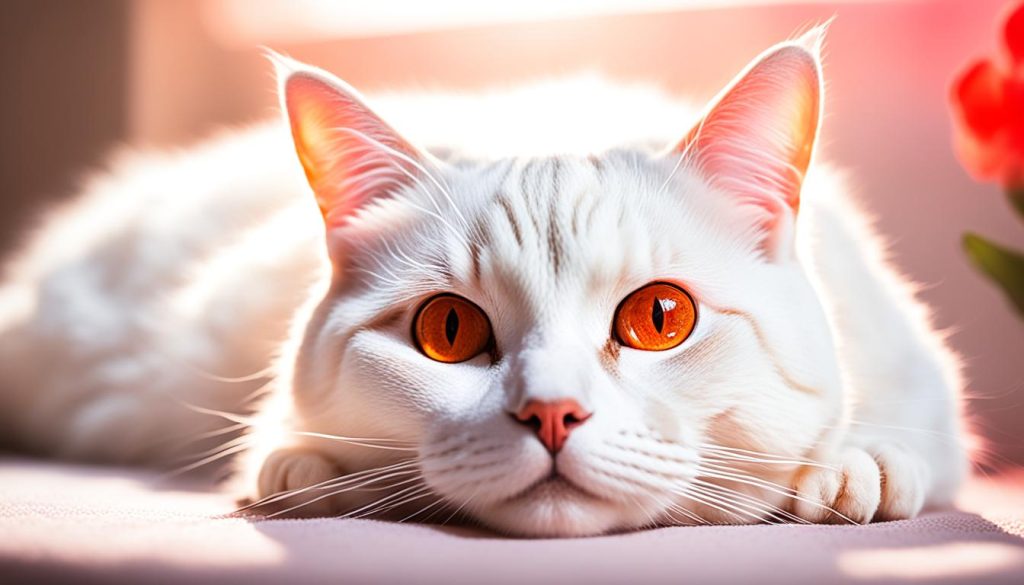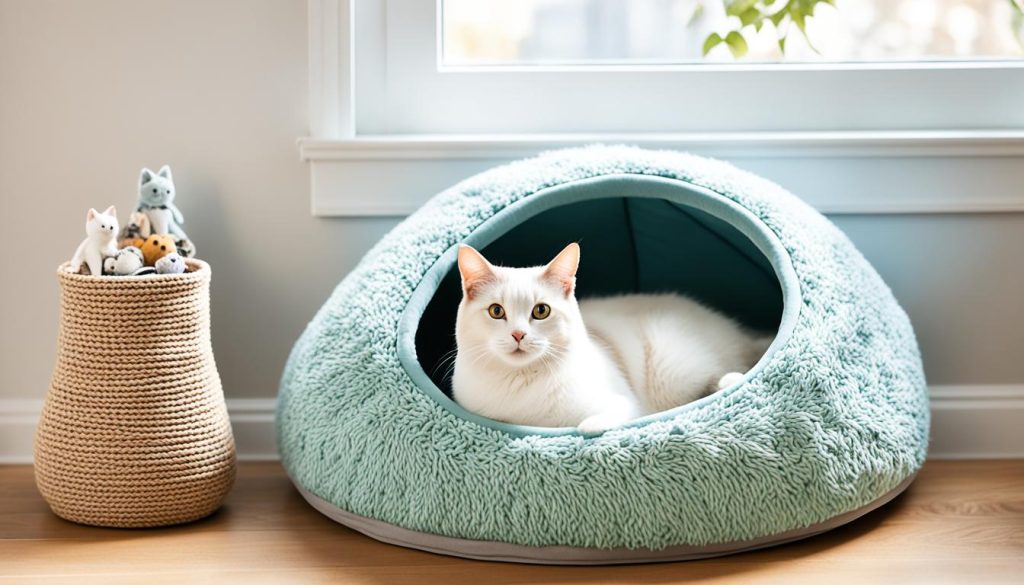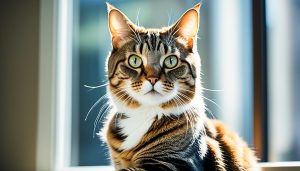Understand your cat friends and expert insights from cat behavior experts for happy healthy cats
One of the most common reasons for owners giving up their cats is unwanted behavior. To ensure the best for your cat and avoid such pitfalls, it’s crucial to understand the underlying reasons for their problem behavior. Expert insights from cat behavior specialists can provide new understanding and promote the physical and psychological well-being of your cat, leading to long and fulfilling relationships.
Key Takeaways:
- Consulting cat behavior specialists can help you understand and address your cat’s behaviors effectively.
- Expert insights from specialists contribute to the optimal wellness of your cat, ensuring their happiness and health.
- Understanding your cat’s needs and seeking professional advice leads to a strong and satisfying relationship with your pet.
- Addressing unwanted behaviors is essential to prevent owners from giving up their cats.
- Cat behavior specialists provide valuable knowledge to promote the physical and psychological well-being of cats.
The Importance of Enrichment for Cats
Cats are fascinating creatures with unique behaviors. To ensure their overall well-being and happiness, it is essential to understand and address their specific needs. One key aspect of cat care is providing enrichment activities that promote mental and physical stimulation.
Enrichment for cats involves creating an environment that allows them to express their natural behaviors and instincts. This is especially crucial for indoor-only cats who might not have the same opportunities as outdoor cats to explore the world around them.
By offering enrichment activities, cat owners can tap into their pets’ innate predator instinct and provide them with both mental and physical exercise. This helps keep their minds sharp and their bodies active, leading to happier and healthier cats.
There are various ways to provide enrichment for cats. One option is to offer interactive toys that simulate prey-like movements, engaging the cat’s hunting instincts. Electronic mice, feather wands, and puzzle feeders are great examples of such toys. Additionally, providing scratching posts and climbing trees allows cats to engage in natural behaviors while also keeping their claws and muscles healthy.
Benefits of Enrichment for Cats:
- Prevents boredom and the development of destructive behaviors
- Promotes healthy physical activity and weight management
- Reduces stress and anxiety
- Improves mental stimulation and prevents cognitive decline
Enrichment activities should be tailored to the individual cat’s preferences and abilities. Some cats may prefer toys that mimic small prey animals, while others may enjoy puzzle toys that challenge their problem-solving skills. It is important to observe and understand the cat’s behavior to provide the most suitable enrichment opportunities.
Creating a cat-friendly environment that allows for mental and physical stimulation is an essential aspect of responsible cat ownership. By implementing enrichment activities, cat owners can ensure that their feline friends lead happy and fulfilling lives.
The Essence of Quality Cat Nutrition
Just like humans, cats are deeply affected by the food they consume. A cat’s diet plays a crucial role in their overall health and well-being. As obligate carnivores, cats require optimal nutrition to thrive. Cat behavior specialists emphasize the importance of providing cats with the right balance of nutrients to support their unique physiological needs.
The Importance of Protein in Cat Diet
Protein is an essential component of a cat’s diet. It plays a vital role in muscle development, tissue repair, and maintaining a healthy immune system. High-quality animal-derived proteins should be the primary focus of a cat’s diet. These proteins can be found in ingredients like salmon, chicken, beef, and turkey. The amino acids found in animal proteins are vital for cats, as they cannot produce them in sufficient quantities on their own.
Whole Food Ingredients for Cats’ Well-being
Choosing cat food made with whole food ingredients ensures that your cat receives the necessary nutrients. Whole food ingredients are minimally processed and retain their natural nutritional composition. They provide essential vitamins, minerals, and antioxidants that support overall health. Incorporating ingredients such as fruits, vegetables, and grains in the appropriate ratio further enhances the nutritional value of the cat’s diet.
Did You Know? Raw or holistically balanced diets are gaining popularity among cat owners. These diets aim to provide cats with a natural and complete nutrition, closely resembling their ancestral diet. They typically consist of raw meat, bones, organs, and vegetables. It is important to consult with a veterinarian or cat behavior specialist to ensure the diet meets your cat’s specific nutritional needs.
Cat Food Ingredients to Avoid
When selecting cat food, it is crucial to be mindful of the ingredients to avoid. Cat behavior specialists recommend steering clear of ingredients such as “by-products,” “meals,” and “flavorings.” These terms typically indicate lower quality and less nutritious ingredients.
Table: Cat Food Ingredients to Avoid
| Ingredients to Avoid | Reasons to Avoid |
|---|---|
| By-products | Low nutritional value, often containing unwanted parts like feathers or beaks. |
| Meals | Lower quality proteins due to the rendering process. |
| Flavorings | Potential allergens or unnecessary additives. |
By being mindful of these ingredients, you can ensure that your cat’s diet is comprised of high-quality, nutritious ingredients that support their overall health and vitality.
Cat nutrition is a critical aspect of cat care, and making informed choices is key to providing optimal nutrition that supports their physical and mental well-being. For personalized advice on cat nutrition, consulting with a cat behavior specialist or a veterinarian is recommended.
The Vital Importance of Hydration for Cats
Cats have unique hydration needs that stem from their wild ancestry. In the wild, cats obtain a substantial portion of their water intake from the prey they consume. To mimic this natural pattern, it’s important to provide wet food that contributes to their fluid intake. Access to fresh and clean water is also essential for keeping cats hydrated and healthy.
Providing fresh water for cats:
- Ensure a constant supply of fresh water is available in a clean water bowl.
- Consider using a cat drinking fountain to encourage more frequent drinking.
- Regularly wash water bowls to maintain a hygienic water source.
Importance of wet food for hydration:
Wet cat food plays a crucial role in keeping cats hydrated. It not only provides essential nutrients but also contributes to their overall fluid intake. The higher moisture content in wet food helps prevent dehydration and supports optimal hydration.
Keeping your cats hydrated is vital for their overall well-being. Proper hydration promotes healthy organ function, aids digestion, and helps prevent urinary tract issues. By addressing their hydration needs, you can ensure that your feline friends stay happy, healthy, and hydrated.
“Cats have a low thirst drive, so it’s crucial to provide them with fresh water and wet food to ensure adequate hydration. Hydration is key to maintaining their overall health and well-being.” – Dr. Lisa Johnson, certified cat behavior specialist
Empathy and Solutions for Aging and Ailing Feline Companions
As cats age, their bodies undergo changes, and they may encounter health issues, such as arthritis. Addressing these issues is crucial for ensuring their comfort and well-being. Cat behavior specialists can provide valuable insights and solutions to help aging and ailing cats live their best lives.
Supplements for joint health in cats can provide relief from discomfort and support their overall mobility. These supplements are specifically formulated to address the unique needs of aging cats, providing them with the necessary nutrients to maintain healthy joints and alleviate pain.
Red light therapy is another innovative solution that can aid in the healing process for cats recovering from illness, surgery, or injury. This therapy uses red light wavelengths to promote cellular regeneration and reduce inflammation, helping to speed up the recovery process and alleviate discomfort.
By incorporating supplements for joint health and exploring the benefits of red light therapy, cat owners can offer a compassionate approach to addressing health issues in their aging and ailing feline companions. These solutions not only help alleviate pain but also improve their overall quality of life and well-being.

Benefits of Supplements for Joint Health in Cats:
| Benefits | Description |
|---|---|
| Pain relief | Supplements can help reduce inflammation and alleviate discomfort associated with joint issues, such as arthritis. |
| Improved mobility | By supporting joint health, these supplements can enhance a cat’s mobility and help them move more comfortably. |
| Prevention of further damage | Supplements can help protect the joints from further deterioration and promote long-term joint health. |
Benefits of Red Light Therapy for Cats:
| Benefits | Description |
|---|---|
| Enhanced healing | Red light therapy promotes cellular regeneration, accelerating the healing process for cats recovering from illness, surgery, or injury. |
| Reduced inflammation | By targeting inflamed areas, red light therapy helps to reduce inflammation and relieve pain in cats. |
| Pain management | The therapy stimulates the release of endorphins, natural pain-relieving chemicals, providing cats with relief and comfort. |
Empathy and understanding are key when addressing health issues in aging and ailing cats. Consulting cat behavior specialists and exploring solutions like supplements for joint health and red light therapy can greatly improve the overall well-being and quality of life for these special feline companions.
Understanding Cat Communication and Body Language
When it comes to understanding your feline friend, cat behavior specialists play a crucial role. They provide valuable insights into cat communication and body language, enabling you to decode your cat’s behavior and build a strong bond.
By observing your cat’s body language, you can gain insights into their emotions and needs. Understanding how cats express themselves through their body language helps reduce stress and foster a harmonious relationship.
“Cats have a sophisticated method of communication, utilizing a combination of vocalizations, gestures, and postures to convey their intentions,” says Dr. Sarah Collins, a renowned cat behavior specialist.
To help you interpret your cat’s behavior, here are some key body language signals to look out for:
Ears and Tail:
- Relaxed ears and an upright tail indicate a content and confident cat.
- Flattened ears and a thrashing tail may suggest aggression or fear.
- A slowly wagging tail can indicate uncertainty or arousal.
Posture:
- A relaxed, loose body posture signifies a calm and peaceful cat.
- A crouched body position with flattened ears may indicate fear or submission.
- An arched back and piloerection (raised fur) can be signs of aggression or arousal.
Vocalizations:
- Purring typically represents contentment, but can also indicate stress or pain.
- Hissing, growling, or yowling are signs of aggression or fear.
- Meowing can signify various needs, including hunger, attention, or discomfort.
By paying attention to these cues, you can better understand your cat’s emotions and respond appropriately. Cat behavior specialists can provide further guidance on interpreting your cat’s behavior and establishing effective communication.
Dr. Collins adds, “It’s important to remember that every cat is unique, and their body language may vary. Getting to know your cat’s individual preferences and signals is key.”
| Behavior | Meaning |
|---|---|
| Slow blinks | A sign of trust and relaxation |
| Exposing belly | Indicates vulnerability and trust |
| Kneading | Displays contentment and comfort |
| Scratching | Marking territory and stretching |
Understanding your cat’s body language is vital for creating a harmonious environment and meeting their emotional needs, resulting in a happy and healthy feline friend.
Creating a Safe and Enriching Environment for Cats
When it comes to our furry feline friends, creating a safe and enriching environment is of utmost importance. Cat behavior specialists can provide expert insights and advice to ensure that your cats thrive in their surroundings. Let’s explore some key considerations for creating a safe and stimulating environment for your beloved cats.
Cat-Proofing the Home
Cats are naturally curious creatures, and their exploration can sometimes lead to accidents or injuries. Cat behavior specialists can offer guidance on cat-proofing your home to minimize potential hazards. From securing windows and balconies to covering electrical cords, these professionals know the ins and outs of creating a safe living space for your cats.
Environmental Enrichment
Environmental enrichment plays a crucial role in preventing behavior problems and promoting the overall well-being of cats. Providing various forms of enrichment ensures that their natural instincts are satisfied and their minds are stimulated. Consider incorporating the following enrichment options:
- Scratching posts or boards: These provide an outlet for your cat’s natural scratching behavior while protecting your furniture.
- Perches and cat trees: These elevated resting spots serve as safe havens and allow cats to observe their surroundings.
- Hiding spots and tunnels: These offer opportunities for play, exploration, and a sense of security.
- Toys and interactive games: These engage your cats mentally and physically, preventing boredom and encouraging exercise.
Preventing Behavior Problems
By creating a safe and enriching environment, you can greatly reduce the likelihood of behavior problems in cats. Boredom and frustration often lead to destructive behaviors or aggression. Environmental enrichment acts as a preventative measure by providing cats with appropriate outlets for their energy and stimulating their minds. Cat behavior specialists can guide you in implementing the right environmental enrichment strategies to prevent behavior issues and ensure the happiness and well-being of your cats.

| Safe Environment for Cats | Cat-Proofing the Home | Environmental Enrichment | Preventing Behavior Problems |
|---|---|---|---|
| Ensures the safety and well-being of cats | Guidance on securing windows, balconies, and covering electrical cords | Provides scratching posts, perches, hiding spots, and interactive toys | Prevents destructive behaviors and aggression through mental and physical stimulation |
| Reduces the risk of accidents and injuries | Creates a safe living space for cats to explore | Offers opportunities for play, exercise, and mental engagement | Encourages positive behaviors and reduces stress |
| Promotes a stress-free environment | Eliminates potential hazards | Stimulates natural instincts and reduces boredom | Fosters a happy and harmonious relationship |
By consulting with cat behavior specialists and implementing their recommendations, you can create a safe and enriching environment that promotes the well-being of your cats. Remember, a stimulating environment not only prevents behavior problems but also ensures that your cats lead happy, healthy, and content lives.
Addressing Common Behavior Issues in Cats
Cat behavior specialists have extensive expertise in handling common behavior issues in cats, including aggression and litter box problems. These specialists are well-equipped to provide expert insights into the underlying causes of these issues and offer effective solutions. By understanding the root causes of these behavior problems, cat owners can address them and create a harmonious living environment for both their cats and themselves.
One of the most common behavior issues in cats is aggression. It can be directed towards humans or other animals, and can have various underlying causes, such as fear, territoriality, or redirected aggression. Cat behavior specialists can assess the specific triggers and develop behavior modification plans that focus on reducing aggressive behavior and promoting more positive interactions. Implementing these strategies can help create a safer and happier environment for all family members.
The other common behavior issue among cats is litter box problems, which can be a major source of frustration for cat owners. Litter box problems can manifest as urinating or defecating outside the litter box, or avoiding the litter box altogether. Cat behavior specialists can help identify the reasons behind these issues, which may include medical problems, litter box aversion, or stress. They can then provide tailored recommendations to address the problem and restore proper litter box usage.
“Cat behavior specialists are experts in understanding the intricacies of feline behavior and can provide invaluable advice and guidance to cat owners.”
Solutions for Cat Aggression
When dealing with cat aggression, it’s essential to work closely with a cat behavior specialist to develop a behavior modification plan tailored to the specific cat’s needs. This plan may involve:
- Identifying triggers: Understanding the situations, people, or animals that trigger aggressive behavior can help in managing and avoiding such situations.
- Positive reinforcement: Providing rewards and praise for calm and non-aggressive behavior can help reinforce positive behaviors and discourage aggression.
- Environmental modifications: Creating a safe and enriched environment can reduce stress and anxiety, which can contribute to aggressive behavior.
Solutions for Cat Litter Box Issues
When addressing litter box problems, a cat behavior specialist may provide the following solutions:
- Addressing medical issues: Rule out any underlying medical conditions that may be causing the cat’s aversion to the litter box.
- Adjusting the litter box setup: Making changes to the litter type, litter box location, or the size and accessibility of the litter box can encourage proper litter box usage.
- Managing stress: Cats are sensitive to changes in their environment, and stress can contribute to litter box problems. Cat behavior specialists can recommend stress-reduction techniques and environmental modifications to alleviate the issue.
By working together with cat behavior specialists, cat owners can find practical solutions to these common behavior issues. These solutions not only improve the well-being of the cat but also strengthen the bond between the cat and its owner.
Socialization and Cat Behavior
When it comes to cats, socialization is a key factor in shaping their behavior and overall well-being. Cat behavior specialists understand the importance of introducing cats to new environments and other animals, as well as encouraging positive interactions. By following their expert guidance, cat owners can navigate the socialization process with confidence and create a harmonious and enjoyable social environment for their feline companions.
Introducing Cats to New Environments
Introducing a cat to a new environment can be a challenging task. Cats are naturally cautious creatures and may take time to adjust to unfamiliar surroundings. However, with the right approach, cat owners can ease their cats into new environments and help them feel more secure.
- Gradual introductions: When moving to a new home or bringing a cat into a new space, it’s important to introduce them slowly. Start by confining them to a small, safe area and gradually give them access to more rooms over time.
- Familiar scents: Introduce familiar scents to the new environment by placing their bedding or toys around the space. This can help them feel more comfortable and familiar with their surroundings.
- Positive reinforcement: Reward your cat with treats and praise when they explore and show signs of comfort in the new environment. This encourages positive associations and builds confidence.
Cat Behavior with Other Animals
“Cats are social but highly territorial creatures. Introducing them to other animals requires careful planning and supervision.” – Dr. Mary Johnson, Cat Behavior Specialist
Introducing cats to other animals, such as dogs or other cats, can be a delicate process. It’s important to follow the guidance of cat behavior specialists to ensure a smooth introduction and minimize any potential conflicts.
- Gradual introductions: Allow the cats to slowly become familiar with each other’s scents by exchanging bedding or using pheromone sprays. Gradually progress to supervised face-to-face interactions, starting with short periods and increasing the duration over time.
- Positive associations: Encourage positive interactions by offering treats and praise when the cats are calm and displaying friendly behavior towards each other. This helps create a positive association between the presence of other animals and positive experiences.
- Proper supervision: Always supervise interactions between cats and other animals, especially during the initial stages of introduction. This ensures the safety of all animals involved and allows for immediate intervention if needed.
Encouraging Positive Interactions in Cats
“Positive interactions between cats are crucial for their emotional well-being. Creating an environment that encourages positive interactions is key to fostering healthy relationships.” – Dr. Emily Davis, Cat Behavior Specialist
To encourage positive interactions between cats, cat owners can implement strategies that promote harmony and reduce stress:
- Environmental enrichment: Provide plenty of vertical spaces, such as climbing trees or shelves, to allow each cat to have their own territory and personal space. This helps prevent competition and reduces the likelihood of aggressive behavior.
- Playtime: Engage in interactive play sessions with each cat individually to release excess energy and provide positive outlets for natural hunting behaviors. This can help alleviate tension and strengthen the bond between cats.
- Feeding routines: Cats are solitary hunters by nature, so it’s important to separate their feeding areas to avoid competition or potential conflicts. Consider using puzzle feeders or interactive toys to provide mental stimulation during mealtime.
By following the guidance of cat behavior specialists, cat owners can navigate the process of socialization, introduce cats to new environments and other animals, and encourage positive interactions. This promotes a harmonious social environment for cats and enhances their overall well-being.
Training and Behavior Modification for Cats
When it comes to training and behavior modification for cats, the expertise of cat behavior specialists can be invaluable. These specialists are well-versed in using positive reinforcement techniques and effective training methods to address undesirable behaviors and encourage desired ones in a gentle and effective manner. By seeking the guidance of cat behavior specialists, cat owners can contribute to their feline companions’ overall well-being and strengthen the bond between them.
Cats, like humans, can benefit from training that focuses on positive reinforcement. This approach involves rewarding cats for exhibiting desired behaviors, such as using the litter box or scratching posts, while avoiding punishment or harsh corrections. Positive reinforcement not only helps cats learn new behaviors, but it also promotes a positive and trusting relationship between cats and their owners.
Behavior modification is another key aspect of training for cats. It involves identifying and addressing behavior problems, such as aggression or excessive meowing, through targeted techniques that modify the underlying causes. Working with cat behavior specialists, owners can gain insights into the triggers and motivations behind their cat’s behavior, and implement effective strategies to modify and manage it.
Training techniques for cats can vary depending on the specific behavior being addressed. For example, clicker training can be used to teach cats new skills or tricks, while counter-conditioning can help cats overcome fears or anxieties. These techniques, along with others recommended by cat behavior specialists, can be tailored to the individual needs and temperament of each cat, ensuring the training process is both effective and enjoyable.
Overall, training and behavior modification guided by cat behavior specialists is essential for promoting the well-being of cats and fostering a harmonious relationship between them and their owners. By investing time and effort into training, owners can help their cats develop good habits, alleviate behavior issues, and create a positive environment for both themselves and their feline friends.
Expert Insight:
“Training and behavior modification are powerful tools for cat owners. Positive reinforcement techniques can create a rewarding learning experience and strengthen the bond between cats and their humans. It’s important to seek guidance from cat behavior specialists to ensure training is done effectively and considerate of a cat’s individual needs.”
― Dr. Emily Wilson, Cat Behavior Specialist
Cat Enrichment Products and Tools
When it comes to keeping our feline friends happy and stimulated, cat behavior specialists can recommend a variety of enrichment products and tools. These items are designed to engage and entertain cats, providing them with the mental and physical stimulation they need to thrive. Here are some examples of the types of products that can enhance your cat’s well-being:
Interactive Toys for Cats
Interactive toys are a fantastic way to engage your cat’s natural hunting instincts. These toys are designed to mimic the movement of prey, enticing your cat to chase, pounce, and swat. From feather wands to laser pointers, there are endless options available to keep your cat entertained and mentally stimulated.
Puzzle Feeders for Cats
Puzzle feeders are excellent for cats who need a bit of a challenge at mealtime. These innovative devices require your cat to work for their food, utilizing problem-solving skills to access their meals. Whether it’s a treat-dispensing ball or a food puzzle toy, puzzle feeders provide mental stimulation and help prevent boredom in your cat.
Scratching Posts for Cats
Scratching is a natural behavior for cats and serves multiple purposes, including maintaining healthy claws and stretching their muscles. Providing your cat with a variety of scratching posts is essential for their well-being and helps redirect their scratching away from furniture. Choose scratching posts that are sturdy and tall, allowing your cat to fully extend their body and engage in a satisfying scratching session.
To enhance your cat’s overall well-being, consult with cat behavior specialists who can provide personalized recommendations for enrichment products and tools. They can help you select items that suit your cat’s individual needs and preferences, ensuring that your feline companion is engaged, happy, and fulfilled.
Conclusion
Expert insights from cat behavior specialists play a crucial role in understanding and addressing cat behaviors, promoting optimal cat wellness, and ensuring the happiness and health of our feline companions. By following the guidance of these specialists, cat owners can create a safe and enriching environment that addresses behavior issues and strengthens the bond with their cats.
Understanding your cat’s needs is fundamental in building a fulfilling and lifelong relationship. Cat behavior specialists provide valuable knowledge and advice on how to meet these needs, ensuring that our cats are happy, healthy, and thriving. Their expertise enables us to interpret cat behavior, address any problems, and create an environment that supports the overall well-being of our beloved feline friends.
To keep our cats happy and healthy, it is crucial to seek expert advice from cat behavior specialists. Their insights can help us navigate common behavior challenges, provide valuable enrichment, and promote optimal cat wellness. By understanding our cat’s needs and seeking professional guidance, we can develop a deeper bond and create a harmonious home environment where our cats can thrive.
FAQ
Why should I consult a cat behavior specialist?
What is the importance of enrichment for cats?
How can I ensure proper nutrition for my cat?
Why is hydration important for cats?
How can I support aging and ailing cats?
How can I understand my cat’s communication and body language?
How can I create a safe environment for my cat?
What can I do about common behavior issues in cats?
How can I socialize my cat effectively?
How can I train and modify behavior in my cat?
What enrichment products and tools are recommended for cats?
Why should I seek expert insights from cat behavior specialists?
Source Links
- https://www.visithawthorn.com/shopnow/product/decoding-your-cat-the-ultimate-experts-explain-common-cat-behaviors-and-reveal-how-to-prevent-or-change-unwanted-ones-barbarasbookstore-76a529
- https://www.everand.com/audiobook/635138916/Decoding-Your-Cat-The-Ultimate-Experts-Explain-Common-Cat-Behaviors-and-Reveal-How-to-Prevent-or-Change-Unwanted-Ones
- https://www.polltopastern.com/post/feline-fine-how-to-keep-your-cat-happy-healthy-and-wise




